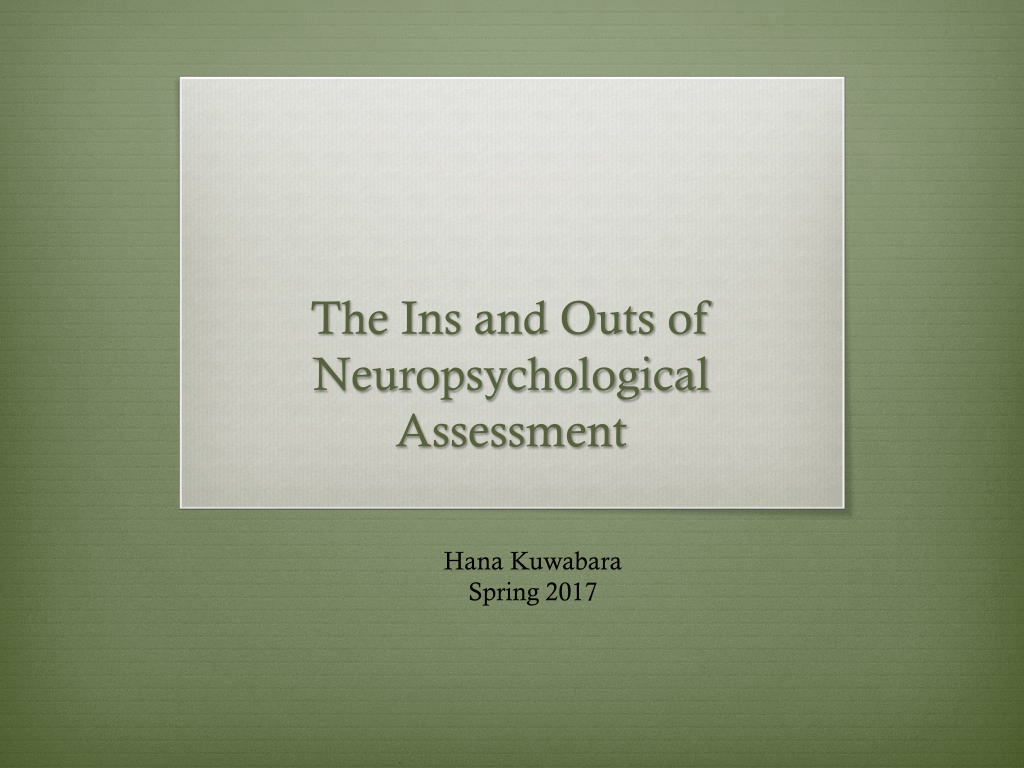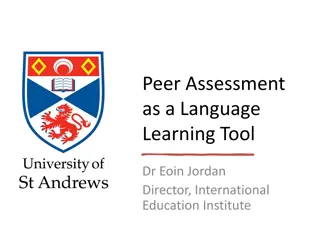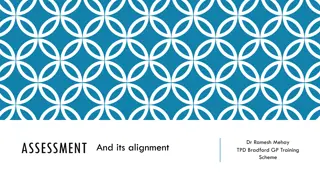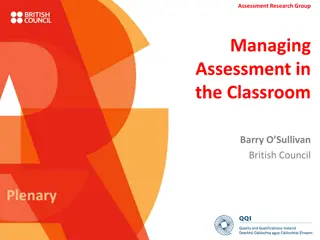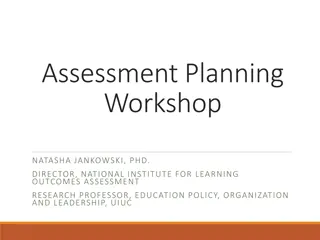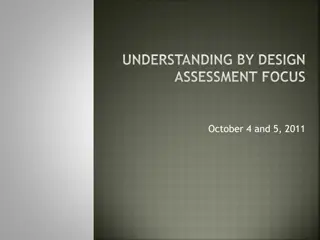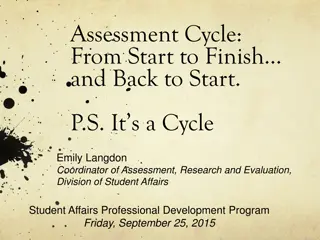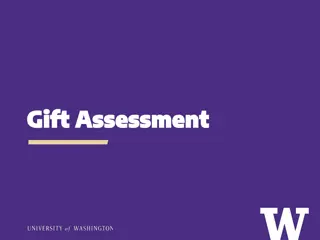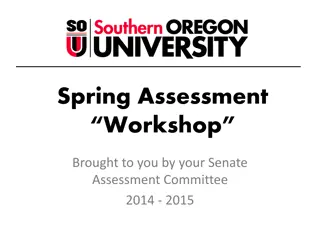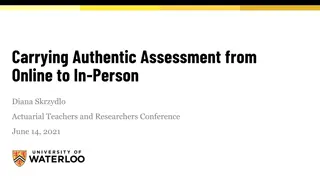Understanding Neuropsychological Assessment: Insights and Applications
Neuropsychological assessment plays a vital role in understanding brain-behavior relationships. This process involves determining cerebral functioning, identifying dysfunction, and assessing cognitive abilities through a combination of interviews, observational data, and testing. The assessment aids in diagnosing, treating, and rehabilitating individuals with neurological conditions across different age groups. Testing is carried out by trained professionals, with a focus on cognitive abilities and quantitative scoring for comprehensive evaluation. Additionally, neuropsychological evaluations complement psychological assessments by incorporating measures related to brain damage and mental health.
- Neuropsychological assessment
- Brain-behavior relationship
- Cognitive abilities
- Diagnosis
- Rehabilitation
Download Presentation

Please find below an Image/Link to download the presentation.
The content on the website is provided AS IS for your information and personal use only. It may not be sold, licensed, or shared on other websites without obtaining consent from the author. Download presentation by click this link. If you encounter any issues during the download, it is possible that the publisher has removed the file from their server.
E N D
Presentation Transcript
The Ins and Outs of Neuropsychological Assessment Hana Kuwabara Spring 2017
Outline Understanding what a clinical neuropsychologist does How to do neuropsychological testing Specifics regarding neuropsychological testing Examples Computerized assessment
Neuropsychology Brain + behavior Assessment, diagnoses, treatment, & rehabilitation Most common activity of a clinical neuropsychologist = neuropsychological assessment Three major areas of specialization/interest: pediatrics, adult, geriatrics
Neuropsychological Assessment 1. Determine level of cerebral functioning 2. Identify the cerebral dysfunction 3. Localize the cerebral dysfunction Done by interviews + observational data + review of records + imaging + neuropsychological measures
Neuropsychological Assessment Assessment of cognitive abilities Determines an individual s current level of functioning Identifies strengths and limitations
Process of Neuropsychological Assessment Neurobehavioral Status Exam (by neuropsychologist) Presenting complaints (from self or others) Mini-mental evaluation QUICK ASSESSMENT What would you do if you saw smoke coming underneath the door? Spell WORLD backwards Who is the president of the U.S? Collateral interviews Review available records Hypothesis guiding the selection of tests to follow
Process of Neuropsychological Assessment Testing (typically by psychometrist) Typically 2+ hours Tests are selected after status exam Details to follow Scoring (typically by psychometrist) Obtain quantitative results Scoring takes half the time of testing Using manuals, obtaining standardized scores If available, comparison tables are made
Neuropsychological vs. Psychological Assessment Neuropsychological assessment popularly known as tests for brain damage Neuropsychological evaluations also use psychological measures (e.g. depression, anxiety, etc.) Neuropsychological evaluations encompass a biopsychosocial perspective
Process of Neuropsychological Assessment Neuropsychological Testing Follow-up (by neuropsychologist) Interpretation of test results Go over strengths/weaknesses Plan of action Make any necessary changes, depending on severity E.g. care giver, health changes, referrals Family members are typically present Typically 3-6 month follow up
How to Do Neuropsychological Testing
Before you see your patient... Organize measures Order for that specific day, spreading out throughout multiple days Critical to avoid interference or tiring the patient You may use a specific administration framework Materials (besides measures) Clipboard Timer Pencils/pens
Administration Framework Motor, language, social cognition, executive function 3.Pre-motor areas, frontal lobes Perception, visuospatial, memory 2. Parietal, occipital, temporal lobes Attention, orientation, effort 1. Brainstem
Other Theories Lurian framework believes each structural area of the brain plays a specific part in the formation of the behavior Other researchers believe his three step framework is not ideal of testing Leaving hardest measures for last will result in poor results (i.e. individual is tired by the end) Suggest hard measures should be administered early in the testing session
You bring your patient back... Introduce yourself Explain what they will be doing today/the next few days Often times, confused as to why they are getting tested Explain what type of tasks they will be doing, the process, your role, importance, bathroom breaks, effort Before diving in, ask if they have any questions
Testing in session... Begin with effort testing Establish effort Establish rapport Do not start with difficult, discouraging tasks! Be aware of any interference between measures Be aware of the patient s needs Are you going too fast/slow? Does the patient exhibit pain? Time for food/bathroom?
Structure of Administration Fixed Same set of tests administered to each patient Cons: time consuming, expensive, irrelevant Flexible Selecting tests based on patient s manifestation Cons: bias procedures, not ideal for large studies
Understanding Results Normative data Age, level of education, gender, ethnicity, SES Comparing to similar individuals Repeated testing Establish baseline Determining rate of deterioration
Summary of Domains Empirical Quasi-empirical Clinical Theoretical Domain English Spanish DSM ICD Luria Sperry CNT HNDNA NA TCN Achievement X X Adaptive func. X X Attention 13/15 14/16 X X X X X X X Auditory percep X Calculation X X Exec. function 13/15 15/16 X X X X X X X X Language 8/15 7/16 X X X X X X X X Memory 14/15 15/16 X X X X X X X X Motor 7/15 6/16 X X X X X X X X Orientation 5/15 5/16 X X X X Perception 3/15 3/16 X X X X X X X X Reading X Response bias X X Sensation 3/15 3/16 X X X Social cognition 2/15 3/16 X X X Visuospatial 12/15 8/16 X X X Writing X X
Overall Frequency Sources Domain Original 39 Unique 31 Included in INCog Memory 37 30 X Executive functions 36 29 X Attention 34 28 X Language 23 21 X Visuospatial 23 19 X Motor 21 17 X Orientation 14 13 X Perception 14 12 X Sensation 9 7 Social cognition 8 6 X Achievement 2 2 Adaptive function 2 2 Calculation 2 2 Effort 2 2 X Writing 2 2 Auditory perception 1 1 Reading 1 1
Trail Making Test A Executive function: Processing speed, visual scanning
Trail Making Test B Executive function: Shifting
Continuous Performance Task (CPT) Attention measure
Continuous Performance Task (CPT) Differences Stimuli, presentation, length Specific versions Target-only modality Signal-target modality Visual better than auditory Different versions measure different constructs: working memory, sustained attention, selective attention, etc. Additional considerations Stimulus duration, probability of target signals, event rate
Cancellation Task Depending on version (# only or letters & numbers), measures attention (only N) and/or perception (L & N)
Cancellation Task A W 3 G 5 6 T L 7 9 N C 5 P 1 Z 9 Y 2A I 8 M 9 Y 2 T 5 B L 6 9 T Y E 7 D 4 G Y 9 H N 7 S 5 2 D J P Q 1 R 9 W P L 4 8 S Using numbers and letters creates pop out effect, minimizing the use of attention. The example above would be a measure of visual perception.
Eyes Test Social cognition
Ravens Matrices http://testyourself.psychtests.com/bin/transfer?req= MnwzMTEwfDQ3MDk2Nzl8MXwxfDE=&refempt = Executive function (specifically abstract reasoning), sometimes classified under intelligence
Computerized Assessment Advantages and disadvantages Computerized Testing Standard paper pencil have been converted into computerized versions Development on novel computerized tests Administration and delivery options Different mode of delivery Additional hardware Considerations Preferred system and program Input devices Exclude or use simple key/button press responses Heads up approach Ideal: touch screen, light pens, voice recognition
Computerized Assessment Advantages Normative data Large and constantly updating Utility Immediate results Reduce expenses Elimination of human error Accuracy and control Instilling basal and ceiling items
Computerized Assessment Disadvantages Validity Process can be long and arduous Limitations in hardware Variance in reaction time/error rate may occur Lack of qualitative information Not for all individuals Limited exposure to technology Certain environmental settings
